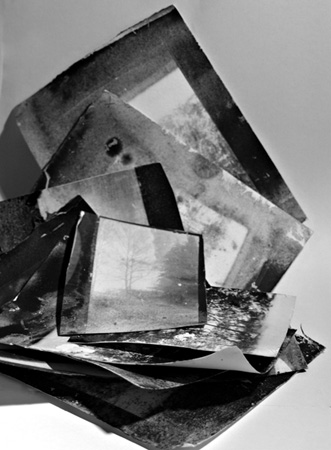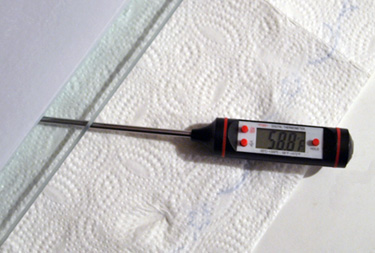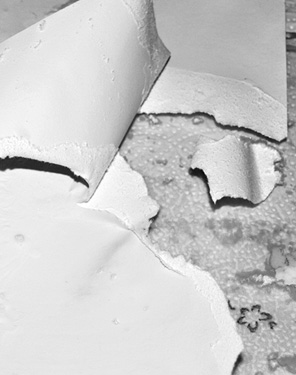Henk Mantel: Pushing The Puddle
February 17, 2013
After the first try at making an emulsion and coating this beautiful Fabriano HP paper,
my conclusion could only be that it all has been a rather limited success.
But nevertheless the emulsion itself renders perfect results. It can be done, that's for sure.
So a couple of days later a second attempt was made. Crowned with triumph this time? No, just a silly mistake of mine. Having achieved some six coated sheets I thought I'd have a well-earned coffee. Forgetting the time and just chatting with my wife about these new endeavors it dawned upon me that the little red lamp was still shining right on the papers. A safelight yes, but not for an hour exposure time at a distance of half a meter. The next day after exposure, fogged of course but unevenly coated as well. Bare patches, thicker lumps of dried emulsion, pimples and craters, recognizable pictures though.
As usual when things go wrong, people (and I am no exception) tend to look at the circumstances instead of thinking about their own limitations. So doubting the quality of the setting properties of the gelatin used, I spent hours trying to understand what the properties of gelatin in general could be. Just reading, searching for clues fitting to my coating problems.
Heavily supported by Denise and PE on Apug I could keep plowing on.
Interesting reading, all of it, e.g. the patent of Oscar Bloom and his gelometer. Hence the Bloom scale. It has nothing to do with the blooming of gelatin. It is just a coincidence in the English language. Apart from a lot of other information this is it: the setting temperature of gelatin is 20°C. Armed with this newly acquired knowledge I spent an evening testing.

Lowering temperatures of a food quality gelatin-water emulsion, recording temperatures and setting times.
Checking the temperature of the coating table and glass plate. As far as my newly gained knowledge goes,
it all has no devastating effect on the actual setting of the gelatin.
In the sense of it being a pitfall or the cause of the coating problems, no.
To paraphrase the sound bite of an American President: It's the coating, stupid.
My conclusion is:
I've got to practice coating with food grade gelatin on simple printer paper.
It will just take a while before I'll be able to have a go at the real thing again.
Being not that ham-handed, I won't be kept off the playing field for long.

All this is a continuing learning exercise. So simple but a nuisance if it should happen to me again.
Don't let the paper dry on the glass plates, if gelatin did seep onto the backside of the paper it acts like glue.
I got three off, one stubbornly stuck to the glass.